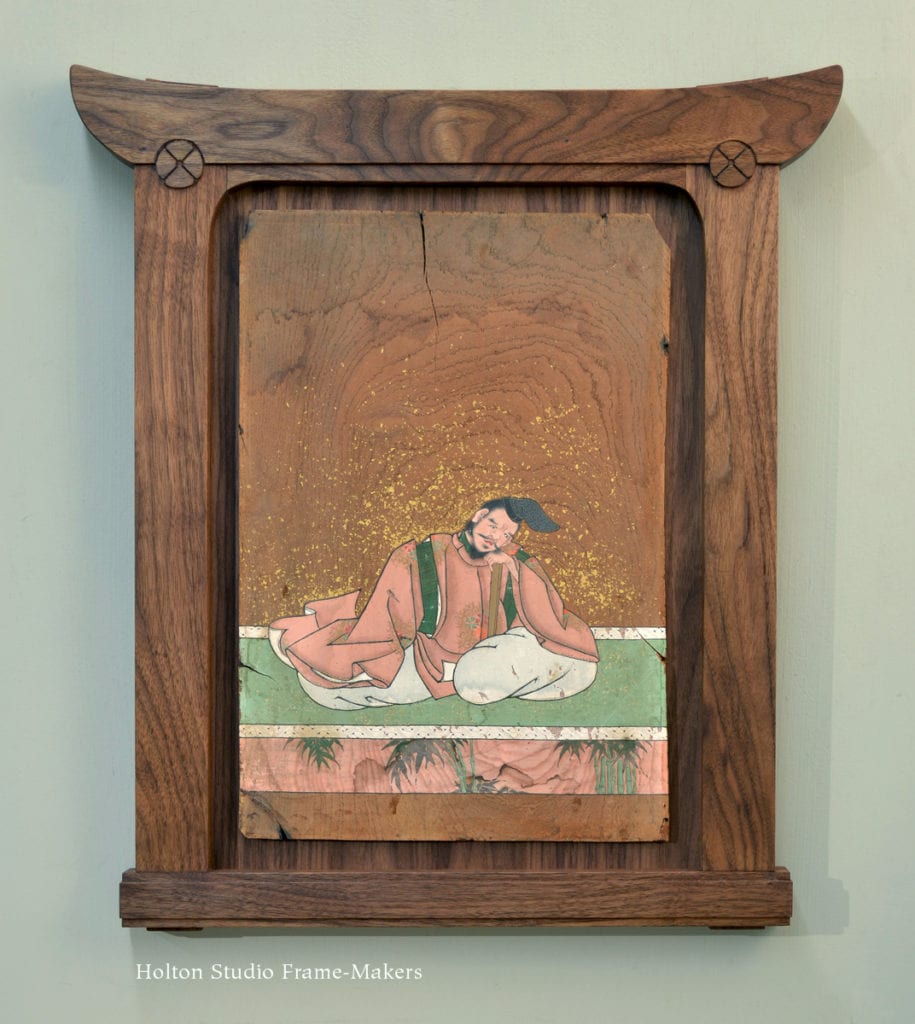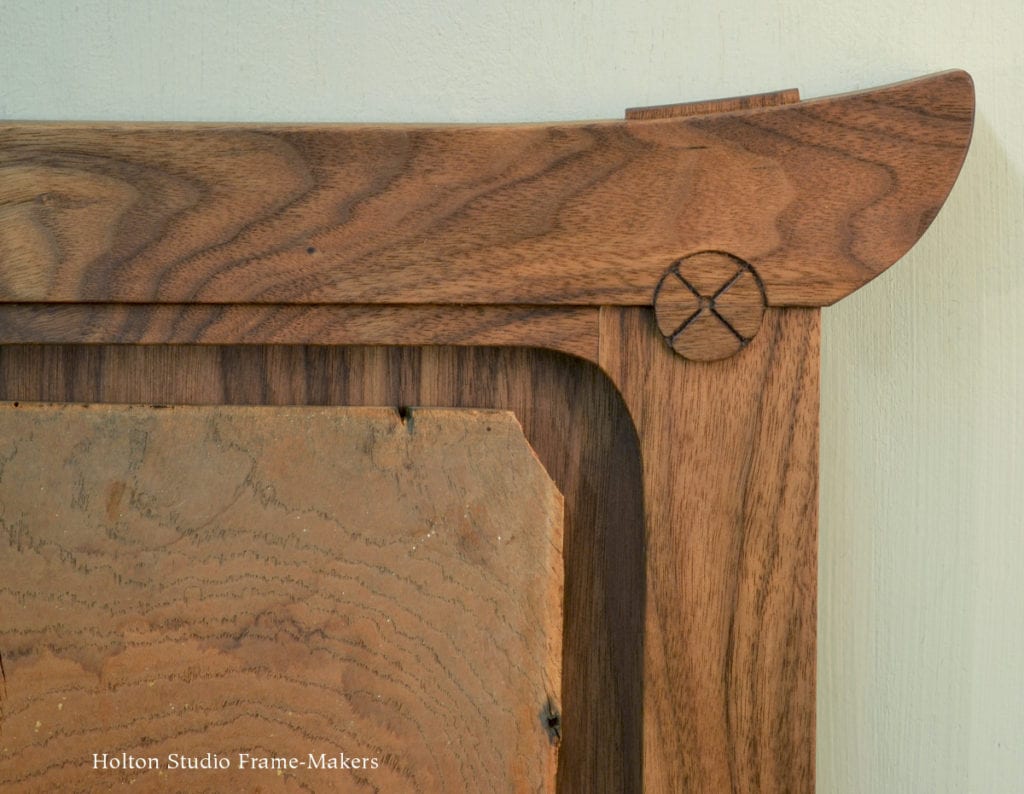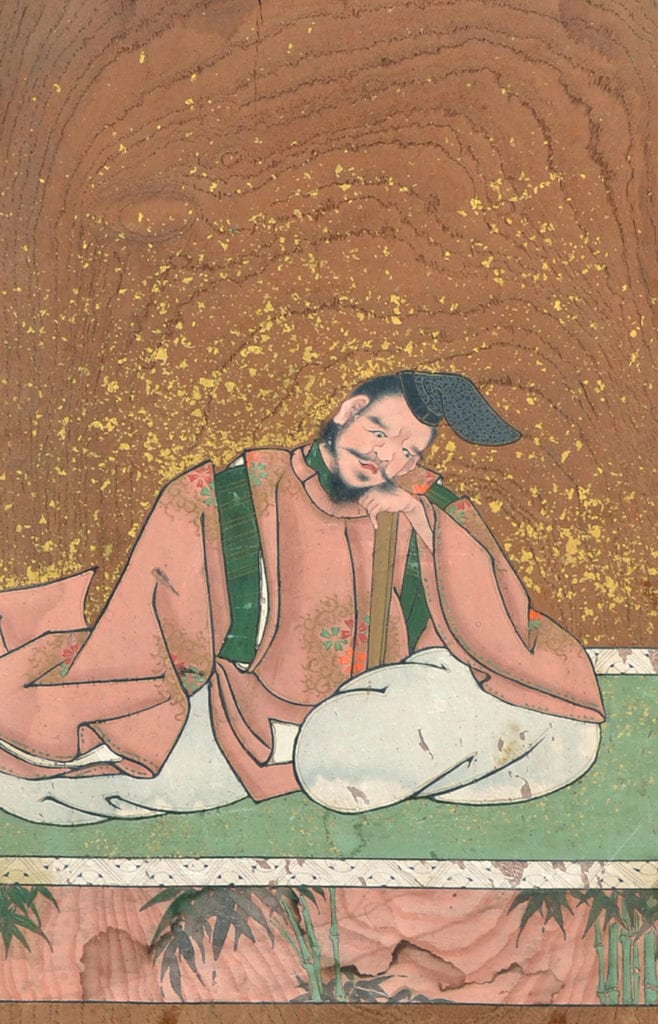Here’s an unusual item we framed a few months ago—an antique Japanese painted panel. The customer gave me carte blanche on the frame design, but knowing his love for Japanese arts and architecture, and feeling that the heft and thr ee-dimensionality of a painting on a wooden panel, as compared to a work on paper or fabric, would benefit from it, I decided to go all out with an architectural form for the frame.
ee-dimensionality of a painting on a wooden panel, as compared to a work on paper or fabric, would benefit from it, I decided to go all out with an architectural form for the frame.
The panel’s about 18-3/4″ x 13-1/2″. The frame, joined with through mortise-and-tenon joints (see corner detail below), is walnut, oiled and waxed. Although the frame is very elaborate for such a small piece, every detail is justified by, and subordinate and in service to, the panel. The bottom rail is stepped, repeating the horizontal bands of the rug the figure’s sitting on, while the flower motifs at the top corners repeat the flower pattern in the rug’s white border. The rounded inside corners at the top sustain the concentric rings of the grain of the wooden panel (as does the whole frame). And the ends of the top (again, see corner detail below) get their shape from the figure’s cap, doing so with an architectural form common in Japanese post-and-beam construction. The wood, which being just slightly cooler and darker than the panel also helps subordinate it to the panel, was carefully selected for interesting grain patterns suitable to the painter’s evident love of wood.
 Although I don’t know the story behind this piece—I have no idea how old it is, or who painted it, or the purpose or place for which it was made—we might easily speculate that the downcast, furrough-browed figure represents the very basic and common human emotion of worry. Perhaps there is behind this a Buddhist kind of mindfulness, which includes the cultivation of self-awareness by simply and calmly observing our emotions—deliberately stepping back from them to consider them dispassionately, and thus gain in self-control and self-understanding.
Although I don’t know the story behind this piece—I have no idea how old it is, or who painted it, or the purpose or place for which it was made—we might easily speculate that the downcast, furrough-browed figure represents the very basic and common human emotion of worry. Perhaps there is behind this a Buddhist kind of mindfulness, which includes the cultivation of self-awareness by simply and calmly observing our emotions—deliberately stepping back from them to consider them dispassionately, and thus gain in self-control and self-understanding.
Often when we do that we discover that our worries are a little silly, and that fixing the mind on what worries us comes at the expense of losing touch with the wonder and beauty of the world. Note how the grain of the wooden panel, which takes up a large proportion of the total area of the panel, is so prominent—the great beauty of the natural creation. Nor can we miss the beauty of the rug on which the figure sits, or, for that matter, the beauty of his clothes and the fabric of which they’re made. And while luxurious robes adorn him and flecks of gold grace him, he shows no appreciation or even recognition of his good fortune. This lovely, benevolent world all goes unnoticed by the distracted, worrisome sitter—and leaves him looking a little humorous. “Worry,” someone wisely said, “is a waste of imagination”—and of life, while we live amidst the beauty of the world. But don’t we all forget that, and don’t we all need reminding, with the help of pictures like this, how silly it is to worry?
This seems to me one of the natural purposes and functions of pictures: “to hold the mirror up to nature,” as Hamlet said about the another art form, that of the theater. That mirror provided by the arts is indispensable to the human capacity for self-awareness which sets us apart from other creatures. The mirror frame, or the frame that is the proscenium of the stage, separates something out from the general chaos of life—something not only needing definition but perhaps too close to us—and places it before us where we’re able to stand back from it. It is then that we are able to contemplate and consider and learn from it.
Thus the place of the thing, where we set it—its framing—is as important as the thing itself. Because the setting defines—or redefines—our relationship to it, giving us the power to reflect on it, understand it and gain at least some measure of control over it.
However old this antique piece is, and as far as it is from its origins, its ancient wisdom is timeless and universal and worth something of a little shrine.
« Back to Blog
